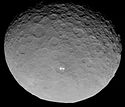1372 Haremari
| Discovery | |
|---|---|
| 11.00[5][6][10] · 11.1[1][7] · 12.2[9] | |
1372 Haremari, provisional designation 1935 QK, is a rare-type Watsonian
Orbit and classification
Haremari is a member of the very small
: 23It orbits the Sun in the central main-belt at a distance of 2.4–3.2 AU once every 4 years and 7 months (1,680 days). Its orbit has an eccentricity of 0.15 and an inclination of 16° with respect to the ecliptic.[1] The body's observation arc begins with its first observation at Heidelberg in February 1928, more than seven years prior to its official discovery observation.[12]
Trojan of Ceres
Long-term numerical integrations suggest, that Haremari is a
of the asteroid belt. It is thought that Haremari is currently transiting from aPhysical characteristics
In the
Rotation period
In November 2009, a rotational
Diameter and albedo
According to the surveys carried out by the Japanese
The Collaborative Asteroid Lightcurve Link derives an albedo of 0.1097 and a diameter of 24.18 kilometers based on an absolute magnitude of 11.1.[7]
Naming
This minor planet jointly honors all the female staff members of the Astronomical Calculation Institute (Heidelberg University) (German: Astronomisches Rechen-Institut), commonly known as ARI. In often published versions, "Haremari" is a composed name and means "the harem of A.R.I.".[2]
Alternative version
According to Ingrid van Houten-Groeneveld, who worked as a young astronomer at Heidelberg, Reinmuth had often been asked by his colleges at ARI to name some of his discoveries after their female friends, as wells as after popular actresses (and not just the female staff at ARI). He then compiled all these proposals to the name "Haremari". However, as Groeneveld recorded, "Reinmuth did not want to publish the original meaning and he, therefore, devised the interpretation of the first sentence in 1948".[2]
References
- ^ a b c d e f "JPL Small-Body Database Browser: 1372 Haremari (1935 QK)" (2017-05-04 last obs.). Jet Propulsion Laboratory. Retrieved 31 October 2017.
- ^ ISBN 978-3-540-00238-3.
- ^ a b "Asteroid 1372 Haremari – Nesvorny HCM Asteroid Families V3.0". Small Bodies Data Ferret. Retrieved 26 October 2019.
- ^ Bibcode:2000A&A...356L..71C. Retrieved 31 October 2017.
- ^ S2CID 46350317. Retrieved 31 October 2017.
- ^ )
- ^ a b c d e f "LCDB Data for (1372) Haremari". Asteroid Lightcurve Database (LCDB). Retrieved 31 October 2017.
- ^ S2CID 119293330. Retrieved 31 October 2017.
- ^ S2CID 35447010.
- ^ S2CID 9341381. Retrieved 31 October 2017.
- ^ ISSN 1052-8091. Retrieved 31 October 2017.
- ^ a b "1372 Haremari (1935 QK)". Minor Planet Center. Retrieved 31 October 2017.
- ^ S2CID 119280014.
- Bibcode:2001DPS....33.5205C. Retrieved 31 October 2017.
External links
- Nueva órbita del asteroide 1.372 Haremari, José María González Aboin, Universidad de Madrid (1954) (in Spanish)
- Les noms des astéroïdes, M.-A. Combes, L'Astronomie, Vol. 87, (1974) (in French)
- Asteroid Lightcurve Database (LCDB), query form (info Archived 16 December 2017 at the Wayback Machine)
- Dictionary of Minor Planet Names, Google books
- Asteroids and comets rotation curves, CdR – Observatoire de Genève, Raoul Behrend
- Discovery Circumstances: Numbered Minor Planets (1)-(5000) – Minor Planet Center
- 1372 Haremari at AstDyS-2, Asteroids—Dynamic Site
- 1372 Haremari at the JPL Small-Body Database


